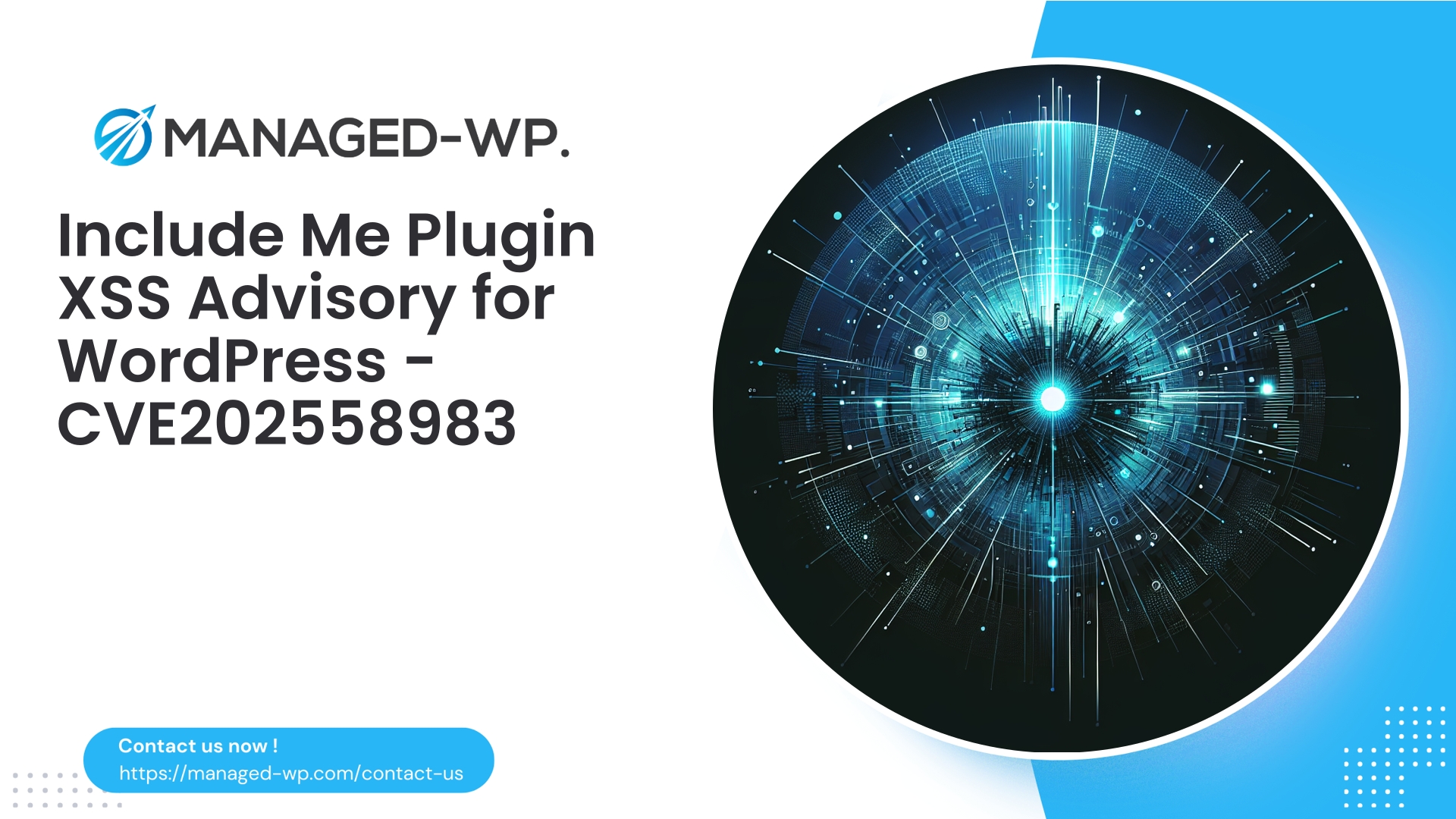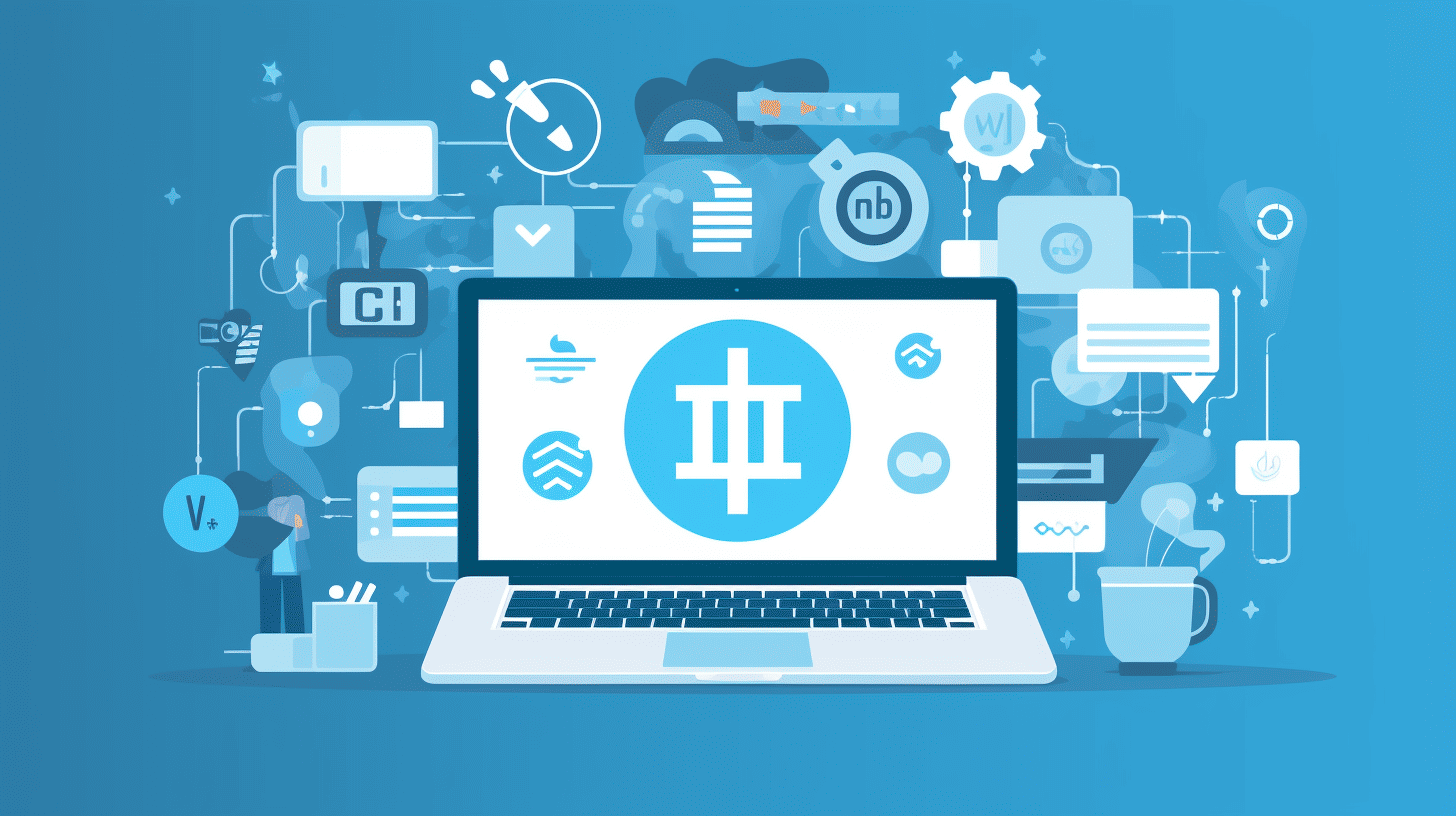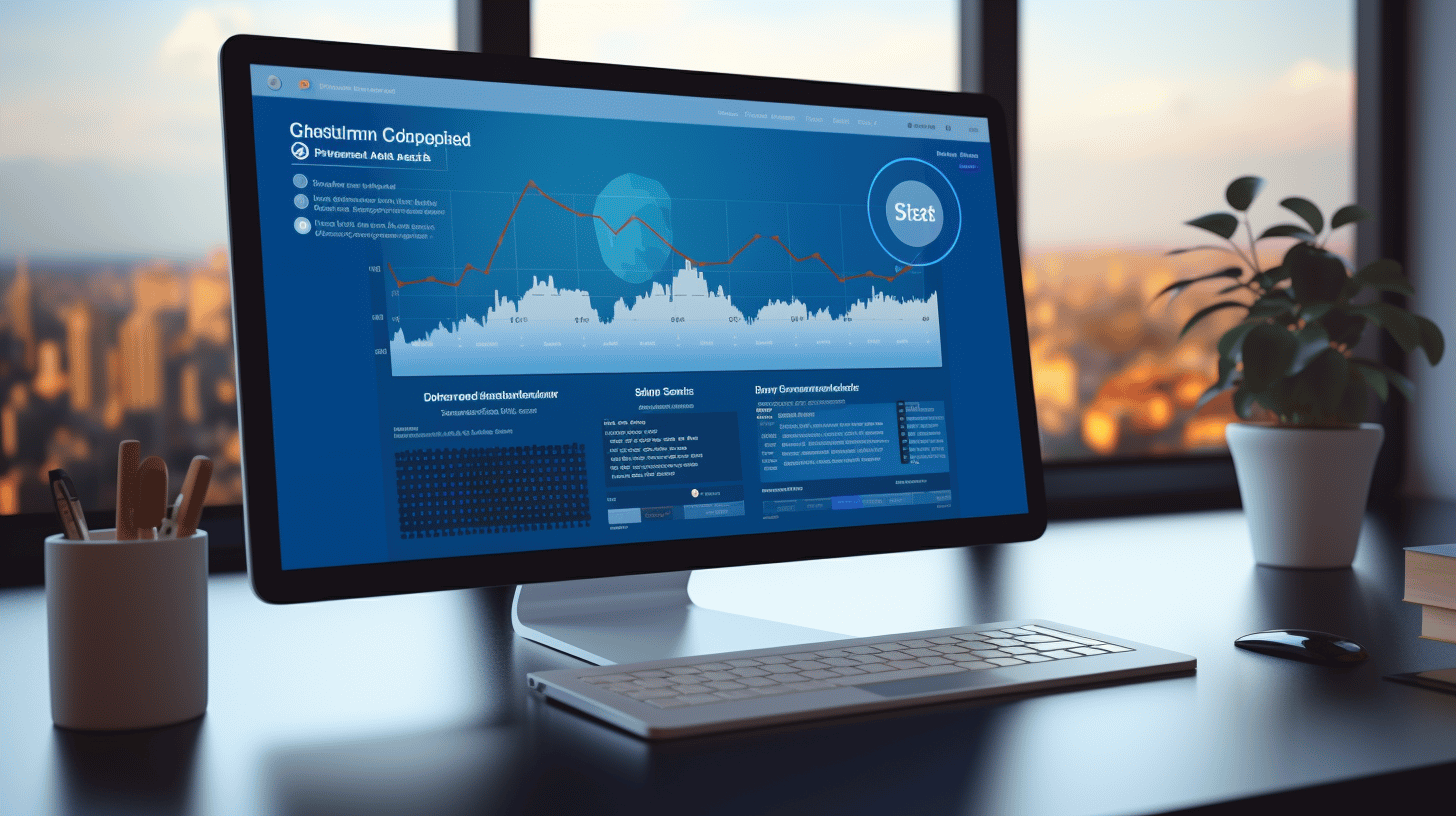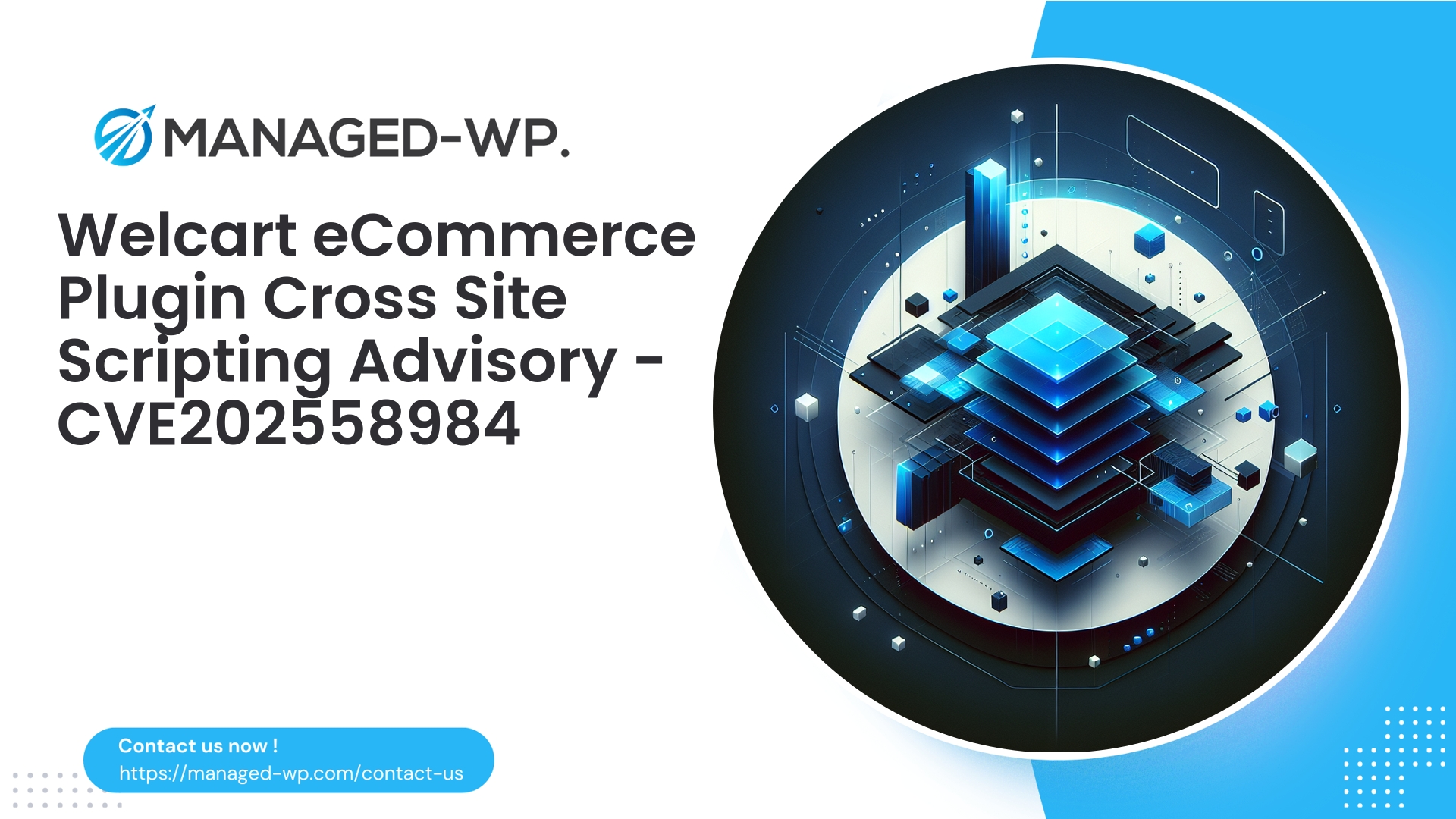| Plugin Name | Include Me |
|---|---|
| Type of Vulnerability | Cross-Site Scripting (XSS) |
| CVE Number | CVE-2025-58983 |
| Urgency | Low |
| CVE Publish Date | 2025-09-09 |
| Source URL | CVE-2025-58983 |
Include Me Plugin (≤1.3.2) XSS Vulnerability: Critical Guidance for WordPress Site Owners
Managed-WP security experts have closely examined a recently disclosed Cross-Site Scripting (XSS) vulnerability impacting the “Include Me” WordPress plugin, affecting versions up to and including 1.3.2 (patched in 1.3.3, CVE-2025-58983). This advisory breaks down what site administrators and developers must understand — the nature of the vulnerability, who is at risk, likely attack scenarios, immediate containment strategies, and long-term defenses including managed firewall solutions to bridge exposure until updates are applied.
With extensive experience in WordPress security incident response, firewall configuration, and secure plugin development, Managed-WP provides practical, no-nonsense guidance designed specifically for site owners and technical teams. This is more than just a CVE summary — it’s actionable intelligence from frontline US security professionals.
Executive Summary
- Vulnerability: Stored Cross-Site Scripting (XSS) in Include Me plugin versions ≤ 1.3.2 (CVE-2025-58983).
- Required privilege: Administrator account access.
- Impact: Injection of JavaScript or HTML that executes in browsers of site visitors or admins viewing affected content.
- Severity: Medium/Low (CVSS ~5.9), but real-world impact varies based on plugin usage and site context.
- Current fix: Update to Include Me version 1.3.3 immediately if using this plugin.
- If update timing is a challenge, deploy managed firewall virtual patches, tighten admin access, and monitor closely.
Understanding Why XSS Vulnerabilities Remain a Threat Even When Admin Access is Required
While an XSS vulnerability that requires administrative privileges might seem less urgent at first glance, in practice, compromised or targeted admin accounts are a common attack vector. Consider these key points:
- Credential compromise through phishing, password reuse, or earlier breaches puts administrative accounts at risk.
- Stored XSS allows malicious scripts to persist within site content, potentially enabling credential theft, backdoor installation, unauthorized admin creation, and site defacement.
- Automated attacker toolkits scan WordPress sites at scale and chain exploits, expanding the attack surface once an XSS payload is injected.
In short, even with a seemingly high bar, initiating control through XSS in an admin context can quickly escalate and cause broad damage.
Realistic Attack Scenarios Enabled by This Vulnerability
Stored XSS injections pose significant risks by executing arbitrary code in victims’ browsers with the following potential impacts:
- Session hijacking and token theft if cookies are not adequately protected.
- Silent administrative takeover by creating rogue admin users or altering credentials.
- SEO poisoning and reputational harm by injecting spam or malicious links into site content.
- Malvertising campaigns redirecting visitors to unsafe domains.
- Phishing campaigns crafted using the site’s legitimate domain.
- Bypassing browser-based security controls to facilitate further attacks.
Note: While modern browsers and secure site configurations reduce some risk, XSS remains a prime attack vector and needs proactive mitigation.
Who Needs to Take Action?
- Any WordPress installation running Include Me plugin version 1.3.2 or earlier is susceptible.
- Admins can be targeted or exploited to inject malicious content, so admin access control is a critical concern.
- Sites with multiple admin users, agencies, or third-party operators have increased exposure and higher risk.
Immediate Actions to Take Within 90 Minutes
- Verify your plugin version:
- Access WordPress Dashboard → Plugins to check Include Me’s installed version.
- Alternatively, use WP-CLI:
wp plugin get include-me --field=version.
- If running version ≤ 1.3.2, update immediately:
- Upgrade Include Me to version 1.3.3 or later. Prioritize this even if your site is complex; test updates in staging if possible.
- If immediate update isn’t feasible:
- Enable site maintenance mode to reduce exposure.
- Restrict admin interface access by IP whitelisting, VPN requirements, or server-level controls.
- Disable the plugin temporarily if it’s non-essential.
- Enforce multi-factor authentication on all admin accounts and rotate passwords.
- Inspect admin-editable content:
- Search for unexpected
<script>tags, event handlers (onerror,onload), or suspicious iframes within plugin-managed pages and settings.
- Search for unexpected
- Review logs and conduct scans:
- Examine server access logs and WordPress audit logs for anomalous admin POST requests targeting plugin endpoints.
- Run comprehensive malware scans and file integrity checks using trusted tools.
Safe Remediation and Recovery Steps If You Suspect a Compromise
If you detect malicious injections or signs of site compromise, follow these critical steps:
- Isolate and preserve evidence:
- Create full backups of files and databases for forensic analysis without overwriting logs.
- Remove injected malicious content:
- Clean posts, settings, and plugin data from any embedded malicious scripts.
- Reset all sensitive credentials:
- Change all admin passwords, API keys, and tokens stored in WordPress.
- Revoke and reissue any external credentials that could be compromised.
- Search for web shells and unauthorized scheduled tasks:
- Look for unexpected files or code in
wp-content/uploads,wp-includes, andwp-content/plugins. - Inspect
wp_optionsandwp_postsfor rogue content.
- Look for unexpected files or code in
- Restore site from a clean backup if necessary:
- If malware removal is uncertain, use a backup that predates the incident.
- Rotate cryptographic keys and SSL certificates if you suspect deeper compromise (rare cases).
- Reinforce security hardening as outlined below.
Organizations with limited internal resources should consider hiring specialized incident response professionals. However, many small teams can halt damage progression by following these methodical steps.
Why Updating Is the Definitive Long-Term Solution
Applying the official patch by upgrading to Include Me version 1.3.3 (or later) resolves the root cause by implementing proper sanitization and capability checks. While managed firewalls and virtual patches are effective stopgap solutions to block attacks, they do not replace applying the vendor’s security update.
Using Managed Firewalls and Virtual Patching to Bridge the Gap
A WordPress-aware Web Application Firewall (WAF) integrated with Managed-WP services can dramatically reduce risk as you plan and execute the update:
- Block suspicious payloads containing scripting attempts targeting known plugin endpoints.
- Enforce input validation, blocking admin POST requests containing raw script tags unless from trusted IPs.
- Rate-limit requests and detect anomalous activity, minimizing automated scanning and mass injection attempts.
- Restrict admin area access using IP whitelists for added security.
- Provide logging and alerting on exploit attempts to support forensic investigations.
We recommend Managed-WP clients enable the dedicated rule set for this vulnerability immediately.
Technical Best Practices for Developers & Site Maintainers
To defend against XSS and similar threats, implement these security measures without sacrificing usability:
- Proper escaping and sanitization:
- Match escaping functions to output context:
esc_html(),esc_attr(),wp_kses()for selective HTML,esc_url(). - Apply input validation functions during data submission:
sanitize_text_field(),wp_kses_post(). - Avoid relying solely on client-side sanitation.
- Store raw data only if reliably escaped upon rendering.
- Match escaping functions to output context:
- Capability and nonce verification:
- Validate user permissions with functions such as
current_user_can( 'manage_options' ). - Verify nonces on form submissions using
check_admin_referer()orwp_verify_nonce().
- Validate user permissions with functions such as
- Enforce least privilege:
- Limit admin privileges to essential users only.
- Utilize granular roles or role management plugins to control access to sensitive plugin controls.
- Secure update handling:
- Implement automatic security updates cautiously, perhaps only for critical fixes.
- Provide transparent upgrade documentation and backup recommendations.
- Log and monitor administrative activities:
- Track who modifies what and when.
- Trigger alerts on suspicious mass changes or new admin accounts.
- Leverage Content Security Policy (CSP):
- Deploy restrictive CSP headers to limit script execution vectors, blocking inline scripts unless explicitly allowed via nonces.
- CSP reinforces defense-in-depth, mitigating impact of injected XSS payloads.
- Set security headers and cookie flags:
- Set cookies with
HttpOnlyandSecureflags. - Use
SameSiteattributes to minimize CSRF risks. - Apply
X-Frame-Optionsor frame-ancestors directives to prevent clickjacking attacks.
- Set cookies with
How to Safely Determine If Your Site Is Affected
- Identify the Include Me plugin version:
- WordPress Admin → Plugins, or via WP-CLI with
wp plugin get include-me --field=version.
- WordPress Admin → Plugins, or via WP-CLI with
- Search plugin data for suspicious content (read-only):
- Query tables and options prefixed with “include-me” and review for injected
<script>tags or suspicious attributes likeonerror,onload. - Export data or perform read-only dumps for offline analysis.
- Query tables and options prefixed with “include-me” and review for injected
- Review admin activity logs:
- Use activity or audit log plugins to filter for recent POST or content modifications related to the plugin.
- Analyze web server logs:
- Look for POST requests with suspicious payloads targeting plugin endpoints, especially content types like application/x-www-form-urlencoded or multipart/form-data.
- Run a malware or static code scanner:
- Use recognized security scanners to detect known XSS indicators in your code and database.
Important: Avoid running destructive exploit tests on live production sites. Favor non-invasive, read-only checks and conduct active testing in a staging environment.
Additional Considerations for Multi-Site Operators and Agencies
- Maintain an accurate inventory and audit all client sites for vulnerable plugin versions.
- Deploy staged updates to subsets of sites, prioritizing security patches.
- Leverage centralized management tools to automate secure bulk updates with pre-update backups.
- Communicate clearly with clients on risk and necessary mitigations, including potential downtime.
What Responsible Plugin Developers Should Implement
- Consistent input validation and output escaping.
- Explicit restrictions on which fields accept HTML, surfaced clearly in the UI.
- Capability and nonce verification on admin forms.
- Detailed, prompt security changelogs and upgrade instructions.
- A transparent vulnerability disclosure and patching process to reduce time-to-fix for users.
Concise Incident Response Checklist
- Upgrade Include Me plugin to version 1.3.3 or higher (or disable it).
- Enforce multi-factor authentication and reset all admin credentials.
- Take full site and database backups for investigation.
- Scan for malicious files and altered database content.
- Remove all malicious injections and confirm thorough cleanup.
- Revoke any exposed API keys or tokens.
- Monitor for unusual outbound connections and scheduled tasks.
- Engage security professionals if complete remediation is uncertain.
Post-Remediation Hardening Checklist
- Enforce strong password policies and MFA for all admin users.
- Restrict number of admin accounts through role separation.
- Keep WordPress core, themes, and all plugins current with updates.
- Deploy a managed WAF with virtual patching capabilities for emerging vulnerabilities.
- Implement robust backup strategies and regularly test restore processes.
- Establish continuous monitoring, alerting, and periodic security audits.
Why Immediate Action Is Essential
Once vulnerabilities become public, automated scanners and exploit bots flood the internet seeking targets—sometimes within minutes. The speed at which you patch and secure your site directly correlates to your risk level. Delaying updates increases your exposure and the likelihood of compromise.
Even if your site appears low-risk, attackers often exploit sites opportunistically—turning them into launchpads for broader attacks. Treat this like critical digital hygiene: prompt remediation minimizes future headaches and costly incidents.
Protect Your WordPress Site Today with Managed-WP’s Free Security Plan
Enhance your site’s core defenses now with Managed-WP’s free-tier offering. Our managed firewall includes a WordPress-centric ruleset modeled on OWASP Top 10 threats, active WAF protection, malware scanning, and unlimited bandwidth safeguards to block common injection attempts. This baseline protection buys you valuable time to conduct safe plugin updates without urgent risk exposure.
Sign up for the Managed-WP Free Plan here:
https://my.wp-firewall.com/buy/wp-firewall-free-plan/
If you require proactive automated malware removal, virtual patching, or advanced features, explore our premium plans—but start with the free plan today to lower your immediate risk.
Closing Thoughts from Your Managed-WP Security Team
The Include Me plugin XSS issue serves as a stark reminder of the speed with which minor flaws can escalate into serious attack vectors. Thankfully, this is a fixable problem: updating to the patched version permanently closes this gap.
For sites unable to update immediately, layered defenses such as managed firewalls, restricted admin access, MFA, vigilant monitoring, and methodical remediation are your best shields against compromise.
Managed-WP is ready to assist if you need help assessing your exposure, deploying virtual patches, or designing secure update workflows. Begin with the actionable steps outlined here: confirm plugin versions, update promptly, fortify admin controls, and conduct thorough scans.
Keep your WordPress environment resilient—early prevention always beats costly recovery.
Need a tailored incident response playbook crafted for your unique site environment, hosting setup, and admin model? Reply with your site profile and our team will deliver a concise remediation plan you can operationalize within hours.



















